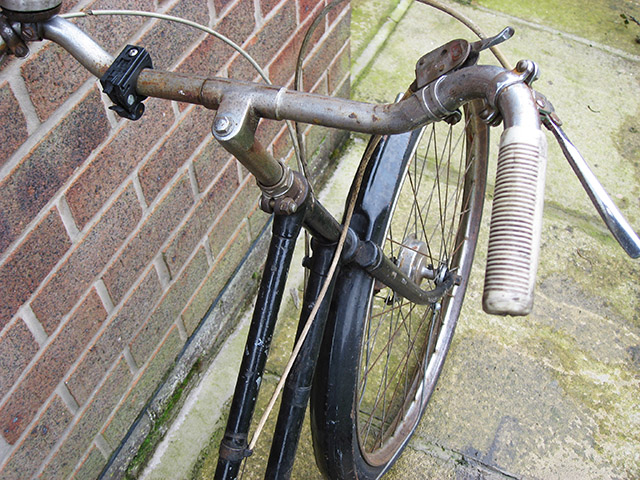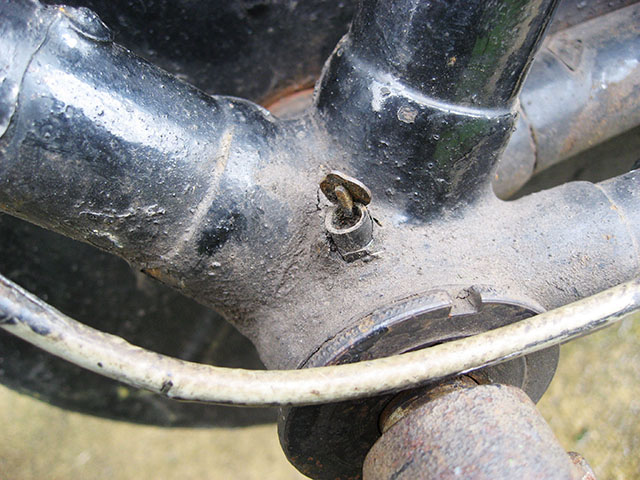This is a Ladies Royal Sunbeam from some point in the 1930's. When I got it a while ago the only thing I knew about it was that is is a Sunbeam. But after a bit of googling, and in particular finding this thread by another owner and this Sunbeam history page I began to piece together a rough history. Mine is almost identical to the one in the thread, which is identified as a Silver Sunbeam Light Roadster. But after looking at the 1936 Sunbeam brochure I'd have to disagree and say that it is a Ladies Royal Sunbeam Light Roadster as the Silver models all appear to lack the prestigious 'Little Oil Bath' chaingaurd.
 |
| Super comfortable 68/68 geometry with a long fork rake |
The original bike will have come with rod brakes, which have long since been removed and replaced (probably in the 40's) with a set of Sturmey Archer 90mm drum brake hubs. The front hub is marked BF9, which denotes it is a BF model hub made in 1939. So it's fair to assume that the rear hub was fitted at the same time. The rear is an AB 3-speed 90mm drum brake hub and is so old it is undated, but will also most likely be from the 1930's.
 |
| The brake levers and shifter dont sit very comfortably on the rod brake handlebars |
It's been through a fair bit of use and no doubt a fair number of owners in its 70+ years. When I got it the brakes where so ineffectual they might as well have not been connected at all but with some air in the tyres it was completely rideable, albeit you had to stop using your feet.
 |
| This is all that remains of the original markings |
At somepoint, probably more than once, it has been given a coat of black paint to cover up various scratches etc. However this means that some original features such as the the transfers on the frame and chaingaurd are gone & there is a lot of overspill onto unpainted parts and the cables. The only transfer that is still there is the headbadge, but even that is mostly gone.
 |
| The oil ports are finely made spring loaded metal caps - quality stuff |
Sunbeams were supposedly the finest bicycles money could buy in their day and this bike is certainly very well made. The main selling feature of these Sunbeams was the 'Little Oil bath' chaingaurd. Which was not any ordinary chaingaurd for 2 reasons -
- It is fully sealed and is supposed to have a small sump of oil at the front end, constantly bathing the chain in fresh oil.
- This bike only has one rear chain stay, the other is the chainguard itself which has a kind of miniature cellular beam inside it which carries the load of the bicycle & rider.
 |
| Image courtesy of www.localhistory.scit.wlv.ac.uk |

I was unsure at first about what to do with this bike. Would it be historic blasphemy to strip it entirely & refurbish from scratch?. Invariably on tv programmes when something antique or vintage has been tampered with, cleaned up, repainted or heaven forbid...take out of the box! the expert will suck his teeth and declare that if is had been original (read : rusty and unuseable) then it would have been worth £50 quadzillion but since you took it out the box and used a bit of brasso on it is now worth £4.37.
I know there is merit in this approach to total preservation, but to my mind this bike has had a sucession of owners all of whom have modified & maintained it in some manner. So since it belongs to me now, and it's already far from original, I intend to simply refurbish it as it stands and get this bike back to usefulness.
The problem with the brakes is most likely down to ancient cables, and glazed/dirty pads. So before I get to properly working on this bike I'll just clean up the brakes and oil the rear hub gear to get this bike rideable enough for the time being whilst it waits it's turn.
 |
| The mudgaurds stays have their own brazed mounts. One of them is badly damaged but will be ok. |
 |
| Bullnose front to the metal mudgaurd |
And to finish....adjustable dropouts.If only all my bikes had these....




































